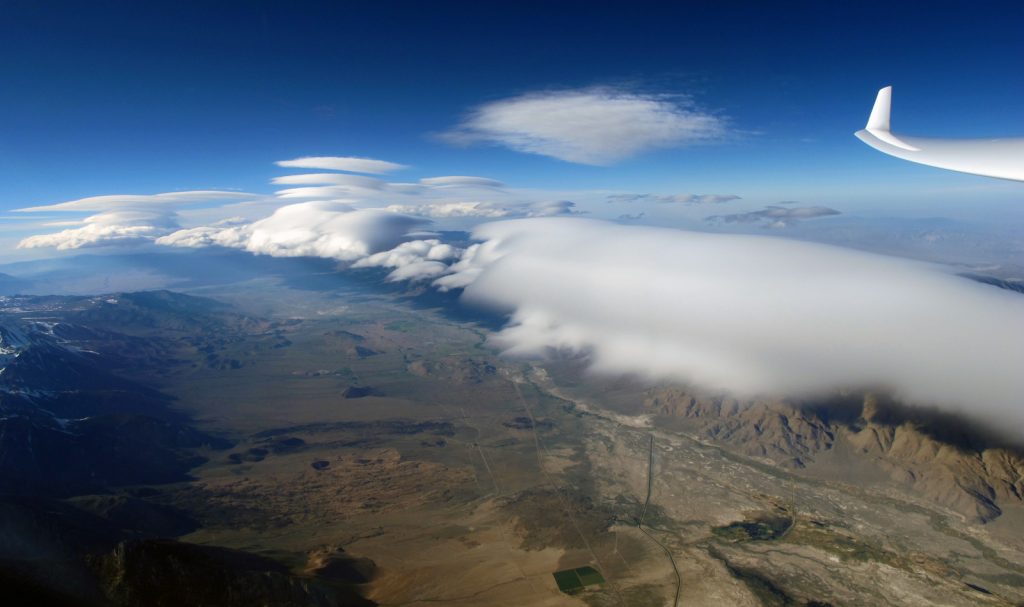
Lenticular clouds in wave, from 27,000 feet in a Kestel 17 glider near Lone Pine, CA
Photo: Gordon Boettger
Written for Flight International – Issue: July 14-20, 2015
It all starts with the winter weather in Antarctica.
Glider pilots around the world regularly climb to altitudes above 20,000, or even 30,000 feet, flying in the strong lift found in mountain wave conditions. But for Perlan 2 to reach 90,000 feet, (read “Lofty Ambitions”) the pilots will need to jump into an express elevator in the Andes, romantically named the Stratospheric Polar Night Jet.
“The polar vortex comes alive in Antarctica in the winter due to the tremendous cooling at the poles, the sinking of the air, and the rotation of the globe,” explains Dr. Elizabeth Austin, atmospheric physicist, and the founder and president of Nevada-based WeatherExtreme Ltd. She joined the Perlan Project in 1998 as Chief Meteorologist, and developed the weather models used in both the Perlan 1 flights, and the upcoming Perlan 2 missions to El Calafate next year.
“You get these sharp temperature contrasts, and with the globe rotating, the jet starts to form,” says Austin. “It circles the pole, and gets these kinds of tails that scoop away from it, and it wiggles and wobbles. Sometimes it pulls away and become this tight jet, and sometimes it spreads out.” The polar night jet starts around 30,000 feet in the mid- to upper-tropopause, and climbs well into the stratosphere, as high as 130,000 to 140,000 feet. The core winds of the night jet can reach an astonishing 260 knots.
A number of meteorological factors will have to line up in order to provide the optimal conditions for Perlan 2’s flights, according to Austin. Prefrontal conditions have to occur during the relatively short, winter daylight flying time, and the polar vortex and night jet have to be very active and over Argentina. The lower level jet and resulting wave have to line up just beside, but not under the night jet, and the orientation of both, relative to the Andes mountain range, is important.
Perlan 2’s pilots will climb in the lower level wave before penetrating the lift generated by the night jet. If the polar vortex and the low level jet stream are not properly aligned, the pilots will likely have to transition through an area of weak climb around 50,000 feet. But if the conditions are exceptional, then the horizontal and vertical wind speeds in the night jet will increase with altitude. “There’s also a zone where we may experience ‘breaking waves,’ says Austin. “As the waves get higher and higher, they actually bend windward, and if they get steep enough, they will break. It creates extreme turbulence, and could tear an aircraft apart.”
Getting accurate, timely data to feed the weather model will be a challenge, says Austin. “The closest [balloon] sounding is about 300 miles north-east of El Calafate, and the next closest is 600 miles north. A bunch of them are launched on the Antarctic continent, but those are inside the vortex. We’re hopefully going to launch our own soundings from upwind, which will transition through the atmosphere we’re going to be flying in,” says Austin. All of the weather data will be fed into modelling software called the Weather Research and Forecasting System which will forecast conditions out for 48 hours at very high resolution. “We’re going to be watching it, not just to guide us when to launch, but where to tow,” she adds.
Austin says that the science generated by the Perlan 2 missions will increase our knowledge of our climate. “We’re going to be studying ozone, because we’re on the edge of the ozone hole. We’re going to learn about the structure of the stratospheric mountain waves and the breaking waves. We’ll learn how breaking waves impact energy, and transfer heat and chemicals to and from the troposphere. That’s an important part of improving climate models, because [current] climate models don’t take breaking waves into consideration.”